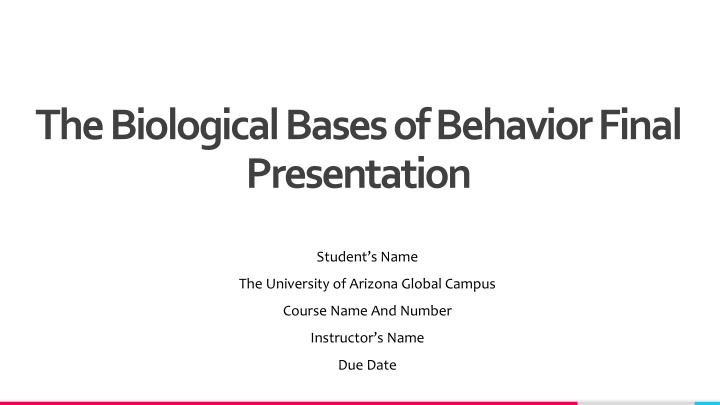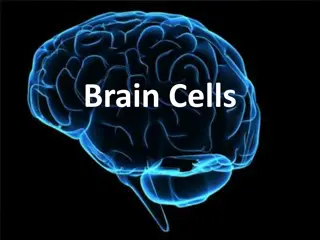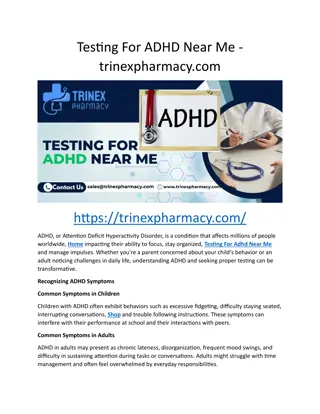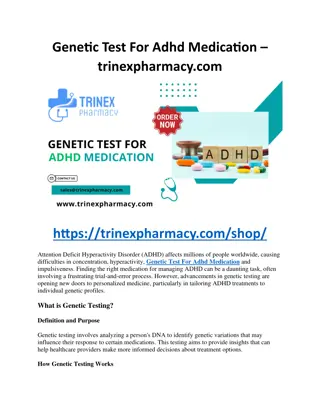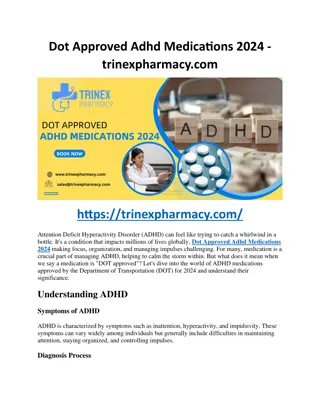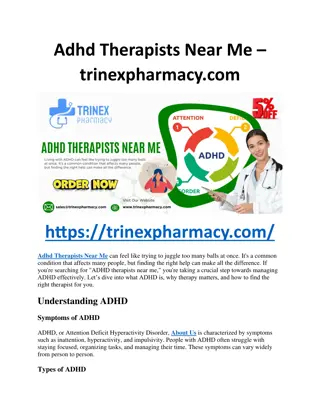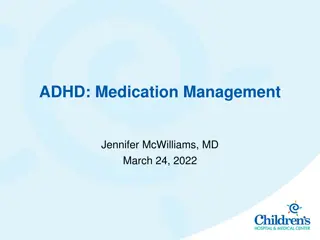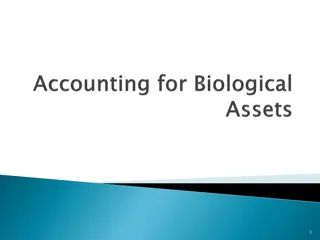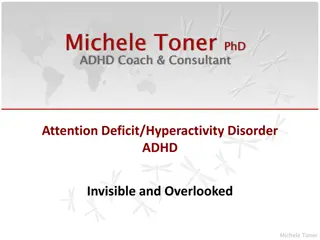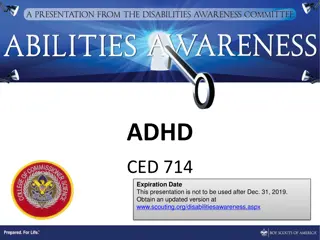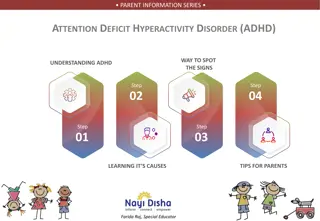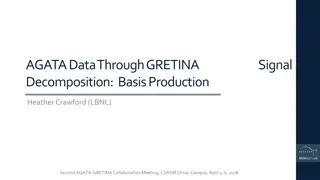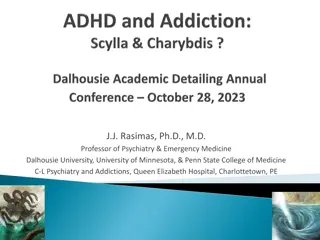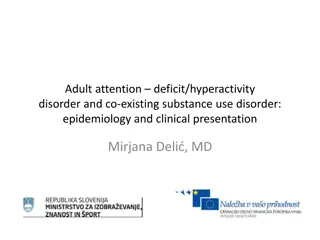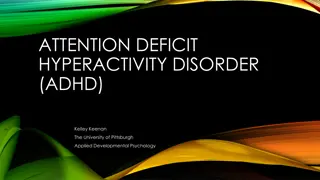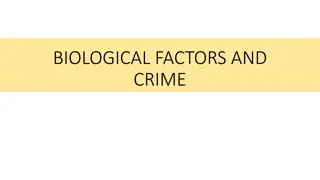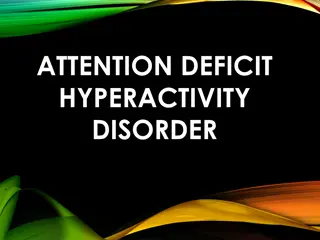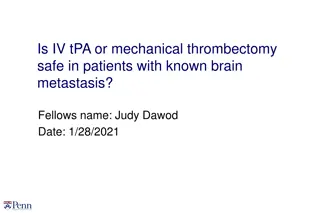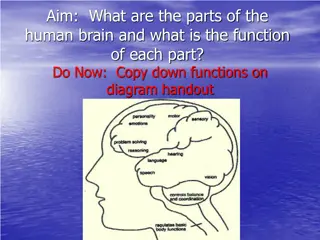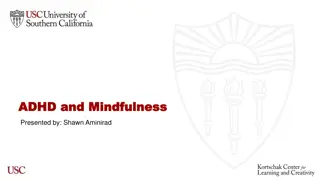Biological Basis of ADHD in Brain Structures & Neurotransmitters" (67 characters)
Neurodevelopmental disorder ADHD affects both children and adults, characterized by symptoms like inattention, hyperactivity, and impulsivity. This presentation delves into the biological underpinnings of ADHD, exploring brain structures such as the prefrontal cortex, basal ganglia, and cerebellum, along with neurotransmitter systems like dopamine and norepinephrine. Hormonal and other biological systems, as well as the lifespan implications of ADHD, are also discussed. Research methods and the history of ADHD studies are highlighted to provide a comprehensive understanding of this complex disorder. (456 characters)
Download Presentation

Please find below an Image/Link to download the presentation.
The content on the website is provided AS IS for your information and personal use only. It may not be sold, licensed, or shared on other websites without obtaining consent from the author.If you encounter any issues during the download, it is possible that the publisher has removed the file from their server.
You are allowed to download the files provided on this website for personal or commercial use, subject to the condition that they are used lawfully. All files are the property of their respective owners.
The content on the website is provided AS IS for your information and personal use only. It may not be sold, licensed, or shared on other websites without obtaining consent from the author.
E N D
Presentation Transcript
The Biological Bases of Behavior Final Presentation Student s Name The University of Arizona Global Campus Course Name And Number Instructor s Name Due Date
Introduction Neurodevelopmental disorder affecting children and adults. Symptoms include inattention, hyperactivity, and impulsivity. Understanding ADHD's biological basis is crucial for developing effective interventions. This presentation explores brain structures, neurotransmitters, hormones, and their roles in ADHD. TREY research 2
Brain Structures Involved Prefrontal Cortex (PFC) regulates attention, impulse control, and decision-making. Basal Ganglia involved in motor control, reward processing, and inhibitory control. Cerebellum supports motor coordination, cognitive processing, and emotional regulation. TREY research 3
Neurotransmitter Systems in ADHD Dopamine regulates attention, motivation, and reward. Reduced dopamine activity in ADHD. Norepinephrine supports focus and alertness. Dysregulated NE levels in ADHD. Imbalances impair attention, impulse control, and reward processing. TREY research 4
Hormonal and Other Biological Systems Cortisol implicated in stress response regulation. Dysregulated levels in ADHD lead to heightened emotional reactivity. Adrenaline contributes to hyperactivity and impulsivity. Overactivity can amplify symptoms. Neuroinflammatory markers linked to ADHD symptoms. TREY research 5
Lifespan Implications of ADHD Childhood implications include inattention, hyperactivity, and academic challenges. Social difficulties and impulsive behavior. Adolescence implications include risk of comorbidities (e.g., anxiety, depression). Impaired decision-making and peer relationship struggles. TREY research 6
Research Methods and History of ADHD Studies Officially recognized as ADHD in the DSM-III (1980). Neuroimaging identifies structural and functional brain differences. Genetic studies explore hereditary influences on ADHD. Evaluate symptom severity and functional impairments. TREY research 7
Key Behaviors and Symptoms Difficulty sustaining focus, disorganization, and forgetfulness. Excessive movement, fidgeting, and difficulty staying seated. Impulsivity: Interrupting others, blurting out answers, and poor self-control. Heightened frustration and mood swings. TREY research 8
Conclusion ADHD stems from complex interactions between brain regions, neurotransmitters, and hormones. Lifespan effects demonstrate the need for age-specific interventions. Advances in research deepen understanding and inform treatments. Continued awareness supports better outcomes for individuals and society. TREY research 9
References Cundari, M., Vestberg, S., Gustafsson, P., Gorcenco, S., & Rasmussen, A. (2023). Neurocognitive and cerebellar function in ADHD, autism and spinocerebellar ataxia. Frontiers in Systems Neuroscience, 17, 1-20. https://doi.org/10.3389/fnsys.2023.1168666 El Ghamry, R. H., Mohamed, M. M., Azzam, H. M., Elhabiby, M. M., Hasan, H. M., Hashish, A. F., Elhamshary, M. M., & Barakat, D. M. (2021). Aggression in ADHD: Relation to salivary cortisol. Middle East Current Psychiatry, 28(1), 1-8. https://doi.org/10.1186/s43045-021-00104-w Koutsoklenis, A., & Honkasilta, J. (2023). ADHD in the DSM-5-TR: What has changed and what has not. Frontiers in Psychiatry, 13, 1- 6. https://doi.org/10.3389/fpsyt.2022.1064141 MacDonald, H. J., Kleppe, R., Szigetvari, P. D., & Haavik, J. (2024). The dopamine hypothesis for ADHD: An evaluation of evidence accumulated from human studies and animal models. Frontiers in Psychiatry,15, 1-19. https://doi.org/10.3389/fpsyt.2024.1492126 Rubia, K., Criaud, M., Wulff, M., Alegria, A., Brinson, H., Barker, G., Stahl, D., & Giampietro, V. (2019). Functional connectivity changes associated with fMRI neurofeedback of right inferior frontal cortex in adolescents with ADHD. NeuroImage, 188, 43-58. https://doi.org/10.1016/j.neuroimage.2018.11.055 Song, P., Zha, M., Yang, Q., Zhang, Y., Li, X., & Rudan, I. (2021). The prevalence of adult attention-deficit hyperactivity disorder: A global systematic review and meta- analysis. Journal of Global Health, 11, 1-9. https://doi.org/10.7189/jogh.11.04009 Tang, X., Seymour, K. E., Crocetti, D., Miller, M. I., Mostofsky,S. H., & Rosch, K. S. (2019). Response control correlates of anomalous basal ganglia morphology in boys, but not girls, with attention-deficit/hyperactivity disorder. Behavioural Brain Research, 367, 117-127. https://doi.org/10.1016/j.bbr.2019.03.036 Zheng, Q., Cheng, Y. Y., Sonuga-Barke, E., & Shum, K. K. (2022). Do executive dysfunction, delay aversion, and time perception deficit predict ADHD symptoms and early academic performance in preschoolers. Research on Child and Adolescent Psychopathology,50(11), 1381-1397. https://doi.org/10.1007/s10802-022-00937-x TREY research 10
